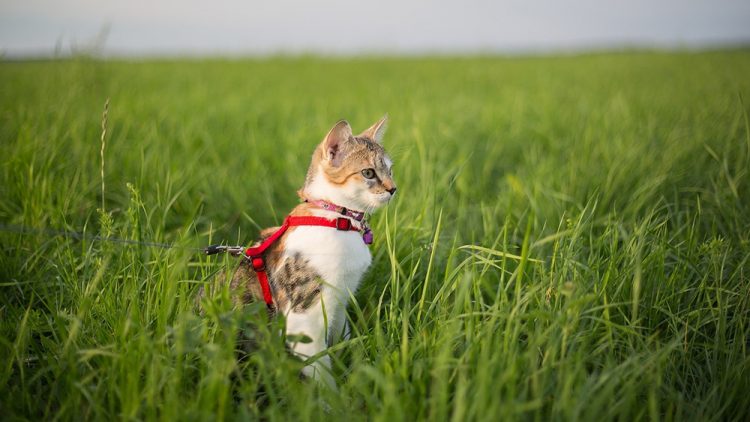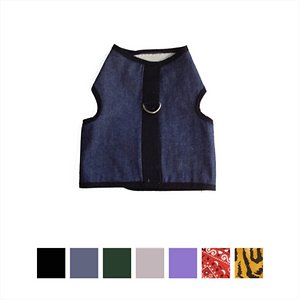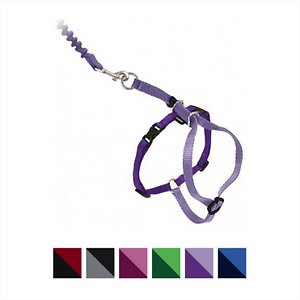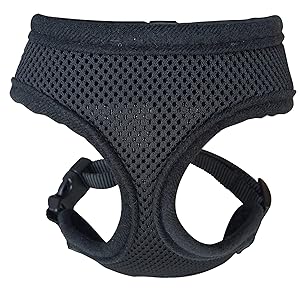To many owners, a cat harness sounds like a disaster waiting to happen. A few years back, they’d have probably been right. With more options than ever for cat harnesses these days, there’s definitely something out there that’ll work for you.
Taking an indoor cat outdoors is something that requires extreme caution. It’s no secret that cats are super quick and flexible, and they’ll get out of almost any situation through the tiniest of spaces.
The fit and effectiveness of each harness depends entirely on how well they match your cat’s size and body shape. It’s hard to guarantee any harness for cats will fit perfectly without fully measuring them beforehand.
- 1 The Best Cat Harness For No Escape
- 2 Kitty Holster Cat Harness
- 3 PetSafe Come With Me Cat Harness
- 4 PACCOMFET Soft Mesh Cat Harness
- 5 Dexil Luxury Padded Cat Harness
- 6 HOUNDNINE Escape Proof Cat Harness
- 7 A Guide To Buying Your First Cat Harness
- 7.1 A Dangerous World for Little Creatures
- 7.2 The Thrill of the Outdoors
- 7.3 Planning For Harness Use
- 7.4 Choosing The Best Cat Harness For You
- 7.4.1 Harness Features
- 7.4.2 Comfort
- 7.4.3 Style
The Best Cat Harness For No Escape

The heading seems a bit strongly worded, but in truth, this is exactly what you’re looking for. You can practice using a cat harness indoors all you like, the game changes completely when you take them outdoors.
You need to be very sure when you opt for a cat harness that the one you’re getting will suit your cat. Certain harnesses for cats contain noisy straps that may frighten some, while others might be uncomfortable with a mesh style fabric harness. Tastes differ, but we’ve tried to accommodate everyone in this article. Below are the best cat harnesses for avoiding escapes and keeping your cat close while outside.
Kitty Holster Cat Harness
Kitty Holster’s award-winning cat harness sets the bar high. It’s super easy to secure around your cat and allows for plenty of movement. A super soft and breathable lining combines with two fuzzy velcro fasteners to make for a far less stressful experience for your cat. The harness itself is machine washable, and the cotton lining avoids the use of any dyes that could irritate your cat’s skin. Available in a selection of charming colors and sizes extra small through extra large, there’s definitely an option that’ll suit you and your cat. We adore this harness and sincerely hope your cat gets along with it. The quality and softness of the materials are second to none, for an extra ten bucks or so compared to most budget harnesses; it’s totally worth it.
PetSafe Come With Me Cat Harness
The PetSafe “Come With Me Kitty” harness is a brilliant design that limits the amount of contact required while remaining comfortable and secure. Secured with two adjustable points to ensure a snug fit, the harness is positioned on the shoulders to avoid any restraint around the throat area. Plastic clasps offer a secure point of attachment, and seem very sturdy indeed. The bungee leash allows for some “give” to remove the risk of tugging when your cat pulls on the leash little. With sizes available for kittens up to large adult cats, this neat little harness is perfect for cats who prefer less coverage than a vest-style harness. Highly recommended.
PACCOMFET Soft Mesh Cat Harness
This wonderful harness is perfectly suited especially for smaller cats, with a circumference of 10″ – 15″ inches around the chest and neck size of no more than 8.3″. Because of the tight sizing, you must get a good measurement of your kitty to be sure she will fit in this harness comfortably. The soft mesh fabric of the comfort padded vest is a type that many cats will welcome against their bodies. It has a soft polyester beneath mesh fabric that allows air circulation to help it feel a little more natural. The closure is a plastic snap-on the neck portion of the vest, so that nothing needs to slip over your cat’s head, which many people find essential in a harness.
Dexil Luxury Padded Cat Harness
Without a lot of excess material and padding, the Dexil Luxury Cat Harness is ideal for cats who prefer less fabric covering their bodies. The Dexil Luxury harness relies on adjustable clips that are secured after placing the harness around your cat’s body; they work wonderfully well. Like any harness, check the security and fit on your cat before relying on it to keep your cat safe from escape. Practice inside, and look for signs that your cat can pull backward or otherwise slip out of the harness when it is properly secured. Adjust the clips as needed to get a secure fit.
HOUNDNINE Escape Proof Cat Harness
This escape-proof cat harness is perfect for larger cats. The adjustable clips on the HoundNine Cat Harness allow tightening of areas that might allow for wiggle room in smaller cats too. The mesh fabric appeals to many cats with its softness and breathability. With clip closures that snap in place after the harness is around your cat’s body, the harness gives a very good sense of security. It features a large, wide, well-padded fabric around the neck area and thinner straps around the body.
We’ve heard nothing but good things about this harness, and all signs point to it being very secure for cats that like to slip out of things around their necks. Be sure to thoroughly cat-test your new harness out for security, fit, and range of movement inside the house before venturing out to more risky, escape-prone situations.
A Guide To Buying Your First Cat Harness

A cat on a leash was almost a non sequitur at one point in recent history it seems. Cats are agile and slippery creatures who don’t often take well to restraints.
For most people not that long ago, the question was “inside” or “outside” cat for a feline companion. Surveys of cat households, however, show a dramatic swing in the “inside/outside” dynamic in recent years.
In the past three decades the percentage of cats considered “inside only” has jumped dramatically. It jumped from some 30 percent of US households in the mid-1980s to some 70 percent of companion cats that are strictly indoor cats who never go outside alone today.
Anyone who knows cats knows that there is no containing a cat in a secure backyard as one might do with a dog. There is no fence nor wall that a healthy cat can’t clear in some way, so the idea of having an “outdoor” cat necessarily means that the animal is able to go anywhere, from busy roads to neighbors’ yards to wooded areas near home.
A Dangerous World for Little Creatures
It is easy to imagine a few of the apparent dangers for a cat in an urban environment. Domestic cats often show a disregard for cars and other animals that may be lurking in the area.
Disease risks are more of a concern to outside cats too. From feline distemper to upper respiratory infections that a cat can catch from other cats, there’s a tonne of real life risks. Of course, parasites like fleas, ticks, mites, and intestinal worms are something that outdoor cats are far more likely to suffer with.
Toxins and poisons are temptations that some cats may not have the discretion to avoid.
The Thrill of the Outdoors
Anyone who knows cats, though, also understands that they do for the most part have the instincts of wild creatures.
They love to watch birds through the window with eager anticipation, they love to scratch their claws on things like trees and wooden fence posts, they are thrilled to sniff and nibble at grass, and of course, they leap at the chance to climb things.
Many cat lovers know that, while indoors is the only true safe place for an inquisitive feline, the tradeoff is usually a bored, anxious, overweight or even depressed house cat who loves to watch the world go by outside the glass.
Almost three out of four people with cats in the home realize three things: cats value outdoor experiences, they are too inquisitive and free-roaming to be allowed out unsupervised safely, and they don’t like to be restrained. Planning quality time out on a walk with a feline friend takes a bit of careful thought and preparation, then.
Planning For Harness Use
Even a trip to the vet’s office can turn quickly to chaos once your cat is out of the carrier. Just a small space to wriggle free is all the average feline needs to hit the ground running and find a place to hide. This is where the best cat harness comes in.
Pretty much all cat lovers are well aware that cats are sensitive and do not like new things. This sensitivity is especially apparent in scenarios that involve some restraint or presence around the cat’s body or neck, which a harness does, of course. A recommended trick to get your cat companion comfortable with a harness is to go slowly.
Unlike dogs who react favorably to the best no pull harnesses, cats will resist harnesses, leashes, and collars. Collars, in particular, should never be used as a restraint as is done commonly with dogs. The pressure of a struggle against a collar and leash is very likely to damage a feline’s delicate trachea.
First, introduce kitty to the new gear at a distance. Leave the harness that you’ve settled on near your cat’s food and provide treats for positive interactions with the harness and you together. Soon you will be ready to incorporate the harness into some personal time with you and your cat.
When your cat is enjoying sitting with you, try either draping the harness over kitty’s back or gently placing it fully on as your cat is more comfortable with it, sharing treats of course, and giving positive feedback as your cat adapts to the feel of the harness.
Take some time at this step as well, allowing your cat to wear the harness around the house and become accustomed to the feel of the snug material before taking the next step, which is to attach a leash to the harness and take the experience outside.
Develop both kitty’s comfort level as well as your sense of assurance that the harness is secure and essentially escape-proof. One fairly common story with cats in harnesses involves the well-known escape artistry of the feline. Most escapes seem to happen with the cat finding a way to essentially turn the harness inside out, like pulling off a t-shirt over your head.
Choosing The Best Cat Harness For You
Harnesses come in a range of different styles and with various closure mechanisms. You should have a good idea of what your cat will react well to before purchasing. For example, if your cat is particularly sensitive to noise, a cat harness with a velcro strap isn’t going to be the best harness for them.
Harness Features
The best harness for cats will include the right mix of fit, feel and quality of materials and closures, and form. When measuring your cat for new harness, measure girth around the chest, snug against the fur for an accurate size estimation. For the neck size, be sure to measure around the area where a collar rests naturally.
The harness you select should fit snugly without pinching or binding anywhere, of course. Generally, you should be able to fit a finger or almost two between the harness material and the cat’s body.
Comfort
While many cats won’t relish the feel of a harness or any type of cat costume, most will get used to the feeling if it fits well and is made of materials that your cat reacts well to. Some people find that their cat doesn’t like mesh material, for instance. Certain types of stiff woven fabrics can be irritating to some cats.
Many cats are frightened of the sound of hook-and-loop (Velcro) closures, so if you know a type of fabric or closure that may be an issue for your feline, look for a harness with other options.
Style
Harnesses for cats come in a few standard styles, which are suited to different cats’ needs and preferences.
- Step-in style cat harnesses allow you to put the harness on with your cat stepping both front paws into it and securing it in place, avoiding slipping it over the head, which can be traumatic for many cats. This style can be less secure than others, so be aware of your cat’s likelihood to struggle and escape, or use it in environments where escape is less likely.
- H-style cat harnesses are some of the most simple designs for cats to wear, with an “H” shaped piece that wraps in front and behind the cat’s front legs and secures with buckles or closures along the cat’s back. Some cats do not appreciate the feel of the thinner straps of the “H” harness squeezing their body, so it helps to know your cat’s feelings about such things
- Vest style cat harnesses are known as the most secure style of harness but can be bulky for some cats, as they consist of the most fabric in contact with kitty’s body. For situations where flight risk may be severe, a vest harness can be most effective to avoid escape attempts
Did you find this article helpful?





